In the second blog post of this series on choosing the correct post-COVID working model, we weigh up the advantages and disadvantages of remote working.
As organizations look to reintegrate workforces post COVID-19, there is a clear recognition that alternative working models have both proved effective from a productivity perspective and offer the potential for cost savings. Current remote working environments and collaboration models have been defined rapidly to address the challenges posed by the pandemic. Looking forward, firms are drawing on those experiences to re-assess the advantages and disadvantages of working models.
Remote working - whether or not it has been on the agenda for organizations to reduce their footprint or lower their overheads and ultimately increase profitability - has become a necessity for most firms to protect the health and well-being of their employees and to prevent further spread of COVID-19.
As a result of the ongoing pandemic, many financial services institutions have been forced to kickstart or reinvigorate their digital transformation plans, whether to adapt their processes for digital solutions to facilitate transactions, or to maintain communication between clients, suppliers and their own employees.
After years of talking about digital transformation but not truly acting upon it, many institutions realized – during the pandemic – that they were better prepared to embrace digitalization than previously thought. Millions of workers have been able to deliver financial services remotely. The message is clear: remote working is no longer a luxury or privilege for employees - it is here to stay.
Remote work is not just about the right equipment and access to a private network, it is also more than digital space and technology. It is about behaviors around communication and collaboration. Trust, accountability and individual outputs all need to be factored into our ‘new normal’ working environment, as does the identification of ways for workers to remain ‘human’ in an increasingly depersonalized (in the sense of fewer physical in-person interactions) working environment.
In the new normal, remote work could be a more permanent fixture than many realize. 74 percent of CFOs intend to shift at least 5 percent of their formerly onsite workforce to remote working permanently post-COVID, according to a Gartner survey . Gartner also notes that almost a quarter of respondents said they would move at least 20 percent of their onsite employees to remote working permanently. According to a paper published by the National Bureau of Economic Research in 2020, 37 percent of U.S. jobs can be done from home, although this percentage varies significantly between cities and industries. Most jobs in finance, corporate management and professional and scientific services can be done from home.

Figure 1: 74 percent of companies plan to permanently shift to more remote work post-COVID-19
Source: Gartner
As many firms rethink their business models to make more extensive remote working a reality, they should not only consider the right technology, but also how to create trust and implement new channels for regular communication, interaction and other work-related activities. To this end, institutions can draw upon the experiences and practices that emerged during the initial period of the crisis. We outline the associated challenges and benefits in the following sections.
Challenges
The transition from daily onsite office work to remote working can pose a range of challenges for employees and their managers.
- Presenteeism and face-to-face management should become less important, as remote working shifts the focus from hours spent in the office to the delivery of specific objectives. This requires outcome-based management of employees alongside new rules for communication, collaboration and feedback.
- Creating a responsive technology to manage remote work. It is not purely about having adequate equipment and infrastructure to access required applications and information, but also the infrastructure in the new home working environment, ranging from high-speed internet access to setting up multiple monitors, webcams and headsets.
- Infrastructure needs to be secure. Working remotely increases cybersecurity risks, so appropriate protection measures are crucial. The simplest solution is to use a VPN to secure both data and online connections. For financial institutions, it is particularly important to stipulate two-factor (or multifactor) authentication to secure client data, and also to monitor its use to ensure compliance.
- Remote working devices should be managed by institutions. Clients’ financial data is the most valuable and sensitive asset to a firm. Applications for monitoring remote workers activities can now check if clients’ information is being manually copied to a computer or printed.
- Remote working expenses and tax must be considered. Additional remote working expenses, such as gas and electricity charges, internet access, and furniture costs need to be taken into account. Any impact on income tax should also be considered. Extra payroll tax registration should be in place in the event of remote working from a different country when meeting thresholds related to income generated or time spent.
- Regulatory compliance must be adhered to. The financial industry is a highly regulated sector with very strict requirements around the security of data and technology networks. Organizations will need to ensure that their employees remain compliant with the rules in a remote working environment.
- Establishing work-life boundaries will encourage more engaged employees. Employees can easily become overworked due to an inability to unplug from work, and there is evidence to suggest this is already happening due to the pandemic. Such boundaries should be agreed on based on an individual’s obligations and priorities.
- Organizations must weigh-up how much remote work is manageable. Not every office activity or process can be conducted remotely, and a realistic working model that combines home and office arrangement should be clarified and agreed.
Benefits
Moving from daily onsite office work to remote working can yield a number of benefits for employees and their managers.
- Lower utility costs
Remote working opens up considerable cost-saving potential for financial institutions, as it enables them to save a significant proportion of their fixed costs related to the rental of office space and equipment, as well as other operating costs calculated per employee that may have a negative impact on a company’s overall profitability.
- Less time spent commuting
Working from home saves the time spent commuting and reduces the associated costs, particularly for employees with long commutes. Many would also assume that avoiding daily commuting is beneficial in reducing stress and increasing job satisfaction and thus the well-being of employees.
- Elevated concentration and productivity
If employees who now work from home were previously used to working in an open-plan office where their concentration was disturbed and their performance impaired, they are likely to experience increased productivity. In addition, they may spend less time in unproductive meetings and concentrate much more on completing their actual tasks and projects.
- Health protection
As the crisis has impressively shown us, social distancing and thus remote working reduces the risk of contracting infectious diseases when travelling by public transport or having direct contact with other people in an office environment.
- Talent acquisition
Remote working gives institutions access to a wider pool of applicants by enabling them to recruit qualified new talent irrespective of their geographic location and potentially in places where it has not been previously possible to seek or attract such talent.
- Work-life-balance
Working from home can help employees and managers to better balance family life with their work commitments, as they are much more flexible with time and space when it comes to carrying out their work. For parents, this can lead to a more favourable work-life balance compared to only working onsite.
- Employee retention
Remote working gives employers the opportunity to develop new forms of collaboration and adopt a degree of flexibility that can increase the loyalty and stability of their workforce. In doing so, institutions can draw upon their experience from the early stages of the crisis to find their optimal working model for remote working.
- Reduced carbon footprint
Remote working is beneficial for the environment and, in turn, good for business. Eliminating daily commuting will lead to less traffic and therefore a lower carbon footprint, which would prevent millions of tons of greenhouse gases from entering the atmosphere. By including remote working guidelines in the business plan, companies can meet the ambitious international climate goals and show to stakeholders that they are responsible, environmentally aware and sustainable, thus positively influencing clients' purchasing decisions.
Working remotely requires a combination of digital skills and self-discipline. It will best suit employees who do not regularly interact face-to-face with customers and can effectively work remotely with defined technical and operational support. It is ideal for independent tasks such as programming, research and analytics, and firms should identify these across all departments as part of a remote strategy.
Sales representatives and loan officers have already been working remotely as a matter of course for a long time. Back office departments that primarily use technology to interact with colleagues elsewhere in the organization are well placed to execute their tasks remotely.
Traders use sophisticated online data and must enter transactions promptly into the relevant systems. This should be manageable remotely once regulation has paved the way, but the challenge is to secure and record communication lines to prevent insider trading. The use of robust phone systems and recording technology mean roles in areas such as claims, collections, sales and call centers lend themselves to remote working, as do project-oriented jobs where outputs are clearly delineated in advance and easily measured.
Conclusion
Facebook, Google, Twitter and Amazon have implemented remote working policies for many or all of their employees around the globe . Like the BigTechs, we believe remote work is here to stay and will become a fundamental part of new working paradigms. Institutions looking to make remote working permanent can build on the experience gained during the pandemic, as they adapt to a new reality. New operating models should be built around greater flexibility and remote operations to deliver enhanced value to clients and stakeholders. To facilitate, firms need new or enhanced infrastructure and applications, alongside improved digital skills for staff and, importantly, a shift in the organizational culture. These endeavours will enable greater adoption of remote working in a meaningful and well-managed fashion.
Capco’s offering includes: Supporting cost management initiatives and enhancing organizational efficiency to define the best location setup; providing hybrid, nearshore and offshore services.
Contacts
Oliver Geiseler, Partner Austria, Germany & Slovakia
M +49 172 131 8328
E oliver.geiseler@capco.com





